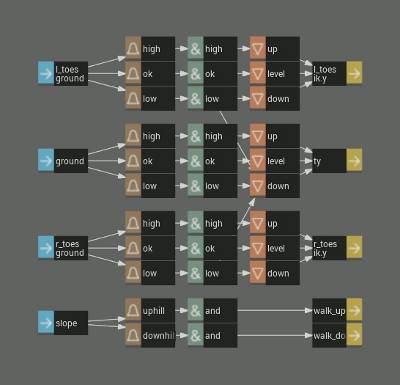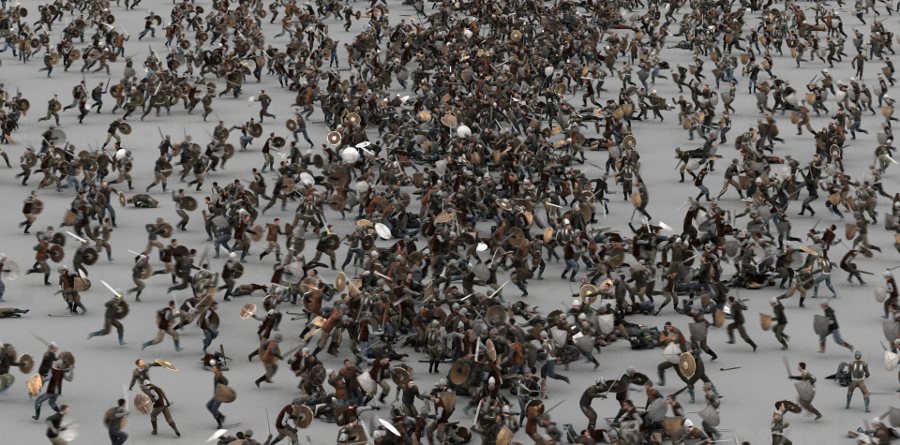Why choose Massive?
Autonomous agents
Massive is a true autonomous agent crowd system and during the simulation Massive agents have complete bodies. This makes it possible for them to interact realistically with each other. For example, if agents need to fend off an attack from a sword wielding agent, or simply shake hands, they can easily do so believably in Massive. Some crowd systems are actually just particle animation systems, and the character geometry and motion is attached to the particles after the simulation has run. Without having complete bodies during the simulation it's almost impossible to create natural behaviour for such interactions. This can make the difference between an epic featured crowd performance and a crowd element that has to be hidden behind foreground elements.

Another advantage of having complete agents during the simulation is that their motion is driven by their motion capture/animation library. So the agents move at the appropriate velocity for their actions, and there's no need to conform the motion library to the agents paths after the simulation.
By applying terrain adaptation during the simulation, the agent's behaviour can be more natural. For example, an agent blending uphill motion on an inclined terrain will progress differently than an agent that is not blending uphill motion.
Open ended behaviour (No black boxes)
|
Collision avoidance, terrain adaptation, flocking, marching in formation, engaging an enemy, or simple finding a nice place to sit, and any other such behaviours are implemented in Massive using eight kinds of simple brain nodes. Most other crowd systems have implemented such behaviours using 'black boxes'. Black boxes are functional elements of software that have various predetermined controls, but the user has no access to the code inside the black boxes. Inevitably the functionality of the black boxes is found to be insufficient for the needs of a particular shot or production. Then the only recourse is to go back to the software developer, and indeed back into the time-consuming software development cycle, and address the issues. This could be disastrous for almost any kind of production, whether it be a television commercial or a major feature film. So such limitations do not exist in Massive. The ready to run agents are supplied with a broad range of capabilities which can easily be edited if needs be. And the brain modules in the ready to run agents can even be copied and pasted into other agents. Any pieces of brain that are made in Massive can be easily modified to suit the particular needs of a production. |

A typical terrain adaptation brain module containing zero lines of code and easily editable |
Natural behaviour
Another advantage of Massive is the fuzzy logic engine. This allows for multiple simultaneous reactions of varying activation to what is going on around the agents. This is the opposite of a finite state machine, which is what other crowd systems use. With a finite state machine the agent has to be doing a particular task at a particular time, making on/off decisions, and if something unexpected happens it may have no way to immediately respond. Massive was designed specifically to avoid this type of robotic unnatural behaviour. In fact just converting the fuzzy logic to binary logic alone is enough to reduce agent behaviour to robotic jerky on/off decision making. Massive's unique Fuzzy logic implementaion is a large part of what makes Massive behaviour so naturalistic.
Combine dynamics with mocap or animation
Some crowd systems can only do ragdoll physics. This can be useful for agents that are completely dead and floppy, but this is seldom the case. People are not ragdolls. Usually dynamics looks best when the agents are still trying to perform, or are not completely floppy. To achieve this it's necessary to be able to combine the character's motion with the dynamics, either over the whole body or for particular parts. Massive's smart stunts technology makes it easy to have an agent perform motion capture or keyframe animation while rigid body dynamics is also affecting the motion. Don't be fooled by marketing hype that claims similar capabilities for other crowd systems; adding a dynamic appendage to an agent is not the same thing as having an agent realistically maintain its balance after being struck.

An agent is struck by an object. While continuing to perform it's action. The agent is shoved by the object and then manages to recover and resume running as before. The only motion capture used is a simple running cycle.
The only animation engine that does not compromise the quality of your motion
A significant advantage of Massive is that Massive doesn't need to modify the motion, whereas other systems need to modify the motion to constrain it to a predefined path. This approach was used in the early days of crowd simulation before Massive was available, and is perhaps the main reason why early crowd VFX were so disappointing. Right from the start this approach was deemed insufficient for use in Massive. The end result is compromised motion quality and unrealistic behaviour.
Some crowd systems attempt to provide cheats for such things as transitions, modifying characters speed or applying motion correction algorithms. This results in motion which is not approved by the animation supervisor or artists. When designing Massive, maintaining the quality of motion was of utmost importance. World class motion capture and animation experts had to be satisfied with the results before it could be used on The Lord Of the Rings film trilogy. While Massive does quaternion blending to ensure smooth results between actions, it does not create transition actions automatically because this only results in compromised quality. And by using Massive's unique motion tree technology, there is no need for specific transition motion.
Film quality ready to run agents
Our library of ready to run agents uses motion capture from Giant Studios and House of Moves. These are considered to be two of the very best motion capture studios in the world. The libraries were designed by, and the motion capture was supervised by motion choreographers who were part of the Massive team at Weta on The Lord Of The Rings film trilogy. With other systems only more modest 'freebie' agents are available.

Get up and running immediately
By using Massive for Maya an artist should be able to start producing crowd shots within a day. We have simple to follow tutorial videos on our youtube channel, and an html based quickstart guide for those who want to get started immediately. No other system beats the ease of use of our software.
The most production proven Crowd system
Massive has been used in production for over 15 years on such films as The Lord of the Rings trilogy, The Hobbit trilogy, the Narnia films, Happy Feet, 2012, World War Z, Godzilla, Dawn of the Planet of the Apes and many more. That's 15 years of refinement and improvements in response to feedback from Massive artists around the world. Massive has been used on more films and on more television commercials and on more television shows than any other crowd software. Massive is the only crowd system to ever be awarded a scientific and technical achievement Academy Award. The design of Massive was based on years of research and development by a veteran VFX professional, and the resultant software was forged in the fires of Mount Doom, during the groundbreaking production of The Lord Of The Rings film trilogy. This may be why Massive artists often tell us that nothing else offers such an artist friendly work flow. Every year we release a new version of Massive with new features, ensuring that Massive continues to be the leader in crowd related visual effects.
Cost effective
Starting at only $3500 for a Massive for Maya license, including a free Ambient agent, Massive is the most cost-effective crowd solution available (that doesn't involve piracy). Why settle for an imitation when you can afford the real thing?
